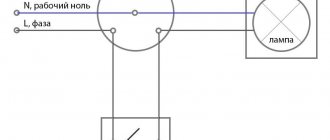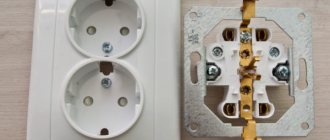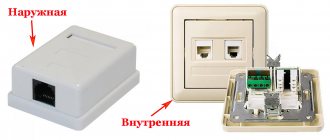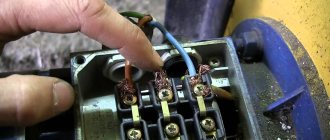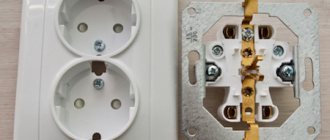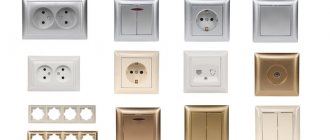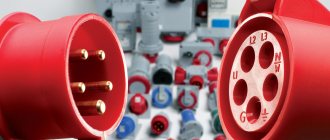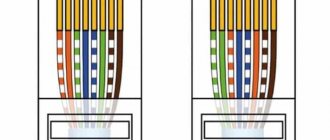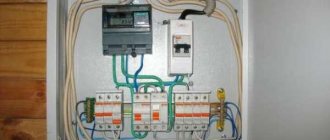A modern family now has a couple of televisions, set-top boxes, DVD players, and computers. And not all of this abundance is ready to work without cables via Wi-Fi, and the signal strength with a bunch of devices will simply not be enough. Therefore, the good old cable and television outlet have a legal “registration” in an apartment or house.
If you are starting a renovation, then it’s time to think about hiding all the cables in the walls so that the apartment does not resemble the lair of a cybernetic spider.
Therefore, let's figure out what sockets are needed for a TV. How many of them to take, where to put them, what to pay attention to and how not to get confused in the tricky names.
Main types of TV sockets
Manufacturers divide TV antenna sockets into three types:
- single;
- terminal;
- checkpoints.
Single or simple TV socket
| TV socket single Legrand Etika | TV socket single Legrand Valena | TV socket simple Schneider Electric Glossa | TV socket simple Schneider Electric Unica |
A single or simple socket is always used independently and this is its main difference with a terminal TV socket. If salespeople in stores or a would-be repairman tell you that there is no difference, look for other specialists and a retail outlet. Because there is a difference, and it lies in the following. A single television socket provides attenuation of no more than 1.5 decibels of power, and the terminal one provides as much as 10 decibels. That is, to put it simply, if you “plug in” a terminal socket instead of a simple one when installing a single point, your TV will display poorly, with interference.
On a note! Therefore, remember, if you have 1 TV, 1 cable and 1 socket, then it is always a simple single one.
Looking ahead, let's say that in the connection diagram with a splitter (for several receivers) simple sockets are used.
Pass-through TV socket
| TV outlet Legrand Etika | TV outlet Legrand Valena | TV outlet Schneider Electric Glossa | TV outlet Schneider Electric Unica |
A pass-through television socket is essentially a tee. It has 1 input and 2 outputs, one of them is for connecting the cable from the TV, and the second is for connecting the cable to the next pass-through or terminal socket. These types of sockets are always installed together, one or more through and at the end - terminal.
Let’s say right away that we don’t recommend getting carried away with installing pass-through TV sockets. Each of them “cuts” the signal power stronger than the final one. So, with low power and without installing an amplifier, the last TVs in the chain will receive a very weak signal. Limit yourself to four pieces per bundle to avoid this situation.
Termination TV socket
| TV socket terminal Legrand Etika | TV socket terminal Legrand Valena | TV socket terminal Schneider Electric Sedna | TV socket terminal Schneider Electric Unica |
The terminal socket closes the chain of passages, this is its main function. But you can also install them on parallel assemblies.
The online store 220pro.ru offers a large selection of television sockets of all types
You can buy both products from leading European brands and Russian ones.
For connoisseurs of interesting design and for those who prefer a uniform style for all electrical installation products, TV sockets from popular series are suitable:
- Legrand: Valena, Etika, Celian, Galea Life;
- GIRA: SYSTEM 55, E 22, F100;
- Schneider Electric: Sedna, Glossa, Odace, Unica;
- IEK: Quart
Choose your series for exclusive equipment of your home TV network or a more affordable working option.
Features and characteristics of the TV socket
The main difference between a TV socket and a regular one is the presence of a screw or spring terminal for connecting the electrical cable of the TV. An additional clamp is used for the contact of the shielding shell. Modern sockets from leading manufacturers do not require additional manipulations to prepare the cable during installation. When an electrical outlet is inserted into the socket, the clamps of the TV socket automatically clamp it, ensuring reliable contact and high signal quality.
The TV socket consists of:
- A housing designed for contact with the antenna cable.
- The outer panel performs the function of protection. When connecting a satellite dish, TV outputs are produced in different colors so that the outlet blends harmoniously into the color scheme of the interior.
- Adder used to combine several connectors:
- radio cable connector;
- satellite signal.
- Caliper. A design element for tightly fixing the inserted wire into the socket.
Connection diagrams for TV sockets
We've sorted out the types of sockets for TV cables, now let's look at the diagrams.
There are 2 main circuits for connecting television cables and sockets - parallel, also known as “star”, and serial, also known as feed-through. Here, in fact, there are no discoveries of America, the same principles as when installing any electrical networks. Television - differs only in lower voltage and refers to a low current.
Connecting sockets for TV according to the “star” scheme
An apartment most often has one television cable input for connecting one TV receiver. But now few people have only one TV, 2-3, or even more. And they all need to be connected to the cable somehow. This can be done through a splitter or splitter.
| Splitter for 2 TVs | Splitter for 3 TV | Splitter for 4 TV |
The device has an input and several outputs. This scheme using a splitter is called “star”.
As you can see from the figure, there is also a signal amplifier in the circuit. Typically, the input TV cable supplies a set power, which is enough for 1-2 receivers. But if there are more TVs, and the neighbors are not far behind, the input value may not be enough. Alternatively, you can ask for additional power from the company that provides you with “television”. They usually have reserves for this. Or be puzzled by installing the amplifier as in the picture.
Single or terminal TV sockets are suitable for star connection. Because each TV will have its own cable going from the splitter.
One tip for choosing a type. If you plan to occupy all the sockets in a star circuit, both terminal and simple ones will do. If some remain unused, take the end ones so that there is no interference on TV screens. The point here is this. The termination socket has a "built-in" characteristic impedance of 75 ohms, like a line. And she doesn’t care if the cable is plugged into the TV. A single socket has not received “its” resistance for balance and borrows it from the TV. And when there is no connected receiver, the imbalance of the socket with the line is reflected on the screens of other TVs in the form of all sorts of image distortions.
Advantages of a “star” connection
- Convenient cable routing with fastening in the junction box. It’s good for installation and for checking, everything is collected at one point.
- A fault on one line does not destroy the entire system, because the lines are independent. If any incident with a cable or socket happens on one branch, the rest will work as if nothing had happened.
- The television signal loses a minimum of power, but with an amplifier it does not lose at all, but is supplemented with additional power.
As for the significant cable consumption with such a scheme, it depends on how the wiring is done. A good craftsman will “spread” the cable optimally and the difference from pulling one thread will be minimal.
Pass-through connection
The initial data is the same, one input and several TV installation points that need to be provided with TV signals. A pass-through serial circuit or “loop” is the laying of one cable with inserts of pass-through sockets. And installation as the last outlet - the terminal one.
Pass-through sockets are made like a tee, they have an input and 2 outputs, that is, the socket receives the signal and divides it into 2 branches. On one you can put the cable from the TV, and on the second the end of the cable to the next pass-through socket. And the cycle repeats. The last in this chain is the terminal TV socket, which closes the circuit. You don’t even have to plug a TV into it, but it should be there.
As already mentioned, it is undesirable to make such a circuit infinite; the signal power drops from point to point. And even with the installation of an amplifier, using the right cable and the right F-connectors, it can turn out that the latest TVs will show very poorly. Despite the built-in automatic signal amplification and adjustment system in the receivers.
Helpful advice! Before constructing any circuit, ask your provider how many TVs can be installed on the line for free. Because some service providers stipulate this, and exceeding the limit must be paid. And if you do it without permission, you will face a fine. There are such tricks, however. So ask away.
We've at least decided on the schemes, now let's talk about installation.
Connection algorithm
The question of how and in what cases a pass-through socket should be used has been considered in detail; now we can move on to the task of connecting it. It is quite possible to perform this procedure yourself, and this does not require special tools or skills.
- First you need to install a mounting box for mounting the socket. For television sockets they use the same mountings that are used for power switches and sockets. To do this, you will need to drill a hole of the appropriate diameter in the wall. This can be done using the appropriate attachment for the hammer drill.
- After this, we install the mortgage box. It can be fixed with self-tapping screws, or you can simply place it on gypsum putties.
- After this, you need to stretch the television cable to the outlet and move from it to the next outlet. As a rule, the cable is hidden from prying eyes, so there is no way to do this without gating the walls. Otherwise, the cable is mounted on the wall in a special plastic box.
Be careful! It is prohibited to install a television cable at the same time as power wires. Since damage to the power wiring can lead to high voltage on the television cable. And this will again lead to malfunction of all TVs. Moreover, the power cable may also interfere with the broadcast.
Now let's proceed directly to connecting the TV outlet.
We first strip the two connected cables. After this, we connect the incoming cable. The proper connection location on the outlet may be indicated by arrows or numbers. To do this, unscrew the screws securing the central braid and core and install the cable. Before clamping the cable, you need to make sure that the central core and the braid do not touch anywhere. Then, using a similar scheme, we connect the cable that powers the next outlet
At this stage, it is very important not to confuse the outgoing and suitable cable. Otherwise everything is absolutely the same
Now we check that the central core and the braid are not touching, and also that the cables are not touching each other. After this, a supply of cable is placed in the embedded box and, finally, the TV outlet is secured.
https://youtube.com/watch?v=Od9e5LgcKyU
Having completed all these steps, you can begin connecting the next outlet.
It should also be mentioned that numerous manufacturers, in an effort to speed up and facilitate the installation process, used all kinds of hinged locks and spring clips. But still, the installation process has not really changed due to innovations. The only thing they were able to eliminate was the need to use a screwdriver.
As you can see, the process of installing terminal, pass-through or single TV sockets is not so labor-intensive. In this matter, the main condition is to choose the right socket itself and its connection diagram. We hope that our article has oriented the reader on this issue, and now anyone can easily select and connect exactly the TV outlet that suits a specific circuit.
How to install a TV socket
Yes, just like any other, neatly and in its place.
Let's start with the height where to put it darling. Let’s say right away - drive away the advisers, lovers of European standards and their “15 centimeters from the floor.” Our task is to hide the tails of the power and antenna cables behind the TV so that it is beautiful and convenient. And according to the European standard, you will then have to hang the TV on the floor and watch from there.
Of course, there are also those who like to set up home cinemas, but there are far fewer of them than those whose TV hangs at a normal height.
Therefore, focus on the edges of the TV screen so that no sockets or cords stick out. And if, in addition to the TV set, other devices will be connected, install sockets in convenient accessibility. Or you will have to pretend to be a monkey, trying to reach the treasured food point.
Optimal height
The height of the wall antenna connectors is the height of hanging or installing the TV; it is advisable to place the sockets in close proximity to the antenna input of the TV receiver. The optimal height is considered to be 1.2-1.4 m from the floor when wall-mounting the TV. And 20-30 cm if the TV is installed on the bedside table.
It would be wise to equip several TV outlets in one room of the apartment. Thus, after rearranging the furniture, you will not have to trench the walls of the room or pull the antenna cable along the floor over a considerable distance.
How to choose a TV socket by installation type
In a good way, it is advisable to hide all cables in the walls, like ordinary power cables. Then there will be no tails anywhere and no damage to them. Hidden cabling is the best option and with the right cable, you will completely forget about its existence. If you have such wiring done or are just in the process of renovation, then take hidden TV sockets.
But if no repairs are planned, and there are suddenly more TVs, the installation will be external. It can be done using baseboards with channels and cable ducts. In this case, overhead television sockets are needed.
| TV socket wall mounting Legrand Quteo | TV socket wall mounting Legrand Quteo | Outdoor TV socket Schneider Electric ETUDE |
Installing a socket in a socket box
Installation of the assembled television socket at the mounting location is carried out using spacer tabs present in its design. The socket itself is additionally fixed in the wall with mounting screws. Before installing them, check the installation geometry by level and, if necessary, adjust the position of the legs.
Tip: the remaining part of the wire should be laid inside the socket box, twisting it into rings. Try to roll the cable carefully, avoiding unnecessary creases and kinks - this may affect the quality of the signal.
How to install a LeGrant TV socket, watch the video below:
How to choose a TV cable
Definitely in terms of signal transmission quality and insulation strength. The attenuation in the cable should be minimal, and the insulation should reliably protect the core from external influences. For hidden installation, only the best representatives are suitable. These are cables SAT 703, SAT 50, DG113, F1160BVM COMMSCOPE (RG-11).
| SAT 703 cable | SAT 50 cable | Cable F1160BVM COMMSCOPE (RG-11) |
These are single-core copper cables with an insulating foam layer and a durable sheath that will feel great under plaster.
An RG-6 cable is suitable for outdoor installation, but if you want to get a better signal, choose cables from the first list. An RG-6 cable can be used to connect the TVs themselves to sockets.
How to connect a TV cable to an outlet
The power antenna cable is connected to the socket in a special socket using a screw. The central core is carefully removed from the insulation and secured in the hole. For better fixation, a part of the braided cable is secured with a second screw through a special plate. This ensures that there is no movement and protects the central core from fracture.
Helpful advice! If you are far from electricians, then it is better not to lay television cables yourself. Trust the specialists with the job, they know all the tricks and subtleties. For example, they will not forget that distances must be maintained between antenna cables and power supplies. Lay at intervals of at least 3 centimeters. Otherwise there will be interference, especially on cables like RG-6 and similar.
TV cable device RG-6U
The television cable consists of 4 parts (see photo below):
- PVC sheath
- External conductor (screen), consisting of metal braid and foil coated with a layer of aluminum
- Dielectric - insulation made of polyethylene or semi-air dielectric filling
- Internal conductor represented by a single copper core
I would like to note that the TV cable can be presented in another design, for example, the screen can consist of copper wires, and the internal conductor can be multi-core, but we will focus on this design.
The mysterious TV RD SAT outlet and its brothers
In addition to regular TV sockets, manufacturers offer products with mysterious names tv rd sat, tv fm sat, tv sat, TV-RD, tv + rj 45. In fact, there is nothing mysterious about them and these are simply combined sockets for connecting 2- 3 different receivers.
It's no secret that providers most often offer packages of terrestrial television, radio, satellite and Internet in addition. If you don’t want to drag a bunch of cables into the apartment, then install a mixer block in the switchboard on the site. It collects signals from several antenna cables into one output cable, and it is brought into the apartment. And in order to then separate the frequencies of different broadcasts, a combined socket is installed to connect a group of receivers.
Such sockets are also useful in houses with cable networks. There, there can be one adder blocks per entrance and one cable is pulled to the consumer at once. To separate different signal frequencies you need a combined socket.
Let's understand the intricacies of names using the example of Legrand products
TV-RD-SAT sockets
TV-RD-SAT sockets can be found in the Valena and Galea Life series. They are designed to connect a television (TV), radio (RD) and satellite receiver (SAT). Suitable for cable networks, they can be either pass-through or terminal.
| Socket Legrand Galea Life TV-RD-SAT pass-through | Socket Legrand Galea Life TV-RD-SAT terminal |
TV-FM-SAT sockets
TV-FM-SAT sockets are present in the Celiane and Valena series. They are used as single cables in home TV cable installations. They are connected according to the “star” scheme, directly connecting to the splitter along one line. The outlet itself can include a TV and radio receiver, as well as a satellite receiver.
| TV-FM-SAT socket star Legrand Valena | TV-FM-SAT socket terminal Legrand Valena | Socket TV-FM-SAT pass-through Legrand Valena | TV-FM-SAT socket Legrand Celiane |
TV-RD (FM) sockets
TV-RD (FM) sockets can be found in the Seliane, Valena, Galea Life series. They are needed in cable TV networks to connect two receivers: radio and television. Moreover, television can be received both terrestrial and on the “collective satellite” principle. By type of design, feed-through, terminal and single sockets are produced
| TV-R (TV-FM) socket single Legrand Celiane | TV-R (TV-FM) socket terminal Legrand Celiane | Socket TV-R (TV-FM) pass-through Legrand Galea Life |
Attention! Sockets with the same names can also be designed with 2 cables. That is, such models have 2 inputs and 3 outputs. They are used to connect separate cables from satellite and terrestrial TV. In this way, you can add satellite channels to cable networks without an adder unit. On the radio plug, the frequency is allocated as in a single-cable combined tv rd sat or tv fm sat socket.
| TV-R-SAT socket for 2 cables Legrand Etika | TV-R-SAT socket for 2 cables Legrand Celiane | TV-R-SAT socket for 2 cables Legrand Celiane |
TV-type sockets - Internet
TV + RJ 45 sockets also have 2 inputs and 2 outputs for TV and Internet cables. This type is used to connect smart TVs.
| TV + RJ 45 socket Legrand Celiane | TV + RJ 45 socket Legrand Celiane | TV + RJ 45 socket Legrand Celiane |
What TV sockets are needed for a satellite dish?
If you have a satellite dish and need to connect TVs to it, then it is most convenient to use combined sockets with 2 inputs TV RD SAT or TV FM SAT. We recommend star wiring with simple sockets. To connect, use the SAT socket.
To summarize, we can say that there are a lot of options for TV sockets, both individually and in assemblies. See what suits you best and don't forget about regular power outlets. They will need to be installed in sufficient quantities, at least 3 pieces each, otherwise it will turn out that there is nothing to power the devices connected to the antennas. And you need to throw an extension cord from another outlet. And we tried so hard to get rid of all the tails from the wires.
FAQ
Question No. 1.
What is a TV outlet that has feedback?
This is a type of terminal that has a connector for connecting a TV cable and a terminal for radio programs. Technical parameters are shown in Table 2.
Table 2. Characteristics of the combined TV-FM socket
Question No. 2.
How many DB are there in TV sockets?
- for walk-throughs – 10-30 dB;
- reflected ones have – 10-20 dB;
- final –1-4 dB.
Question No. 3.
How to dismantle a baseboard socket?
Procedure:
- disconnecting wiring;
- the screw holding the frame is unscrewed;
- the protective frame is removed;
- the disc that serves as child protection is removed;
- the cores are released by unscrewing the fixing screws;
- removing the fixing screws.
Question No. 4.
Which Legrand socket should I choose?
The choice depends on the number of television devices used. When using one device, a terminal or individual device is suitable. Using television and radio – TV-RD. For satellite TV, terrestrial channels and radio – TV-RD SAT.
Table 3. Technical characteristics of the multimedia model
Let's sum it up
The online store 220pro.ru offers reliable, modern and high-quality sockets for connecting a TV in a wide range. Choose them from the catalog of television sockets. As well as a television cable, connectors and other accessories.
| TV sockets | TV cable |
If you have any questions, ask, we will answer and solve all the problems for equipping your apartment with a television network.
Call and ask!
Basic selection options
A modern television receiver is qualitatively different from its analogues that operated in the last century. This happens due to increased operational capabilities and greater versatility. The TV becomes part of a complex multimedia system.
Wireless connections do not always guarantee a reliable connection. A classic TV socket copes with this task much better. Stationary modules built into the wall are presented in a large assortment.
When selecting sockets, it is recommended to pay attention to:
- appearance, which should attract with its neatness;
- strength of materials;
- provided convenience for installation and operation.
The number of TVs used and how they are connected influence which sockets are best to use. You will have to choose from individual, walk-through and end ones. If you decide to place several receivers in the network, then you cannot do without pass-through (with 2 output sockets) and end-of-line receivers (usually located at the end of the line). For example, a high-quality, problem-free connection of 3 TVs requires the installation of 2 pass-through sockets and 1 terminal socket.
Types of sockets for TV
TV sockets come in different types. Universal options for regular cable are available for sale. There are special connectors for connecting a satellite dish or radio. When selecting products, study the description and characteristics. The following criteria are important:
All products are reliable and durable. There are models on sale for different purposes, with different connectors.
Also pay attention to the icons and inscriptions on the case. There should be a symbol in the form of an arrow facing inward.
There is another arrow pointing upward.
If your model has 2 arrows facing in different directions, then this is a pass-through TV socket. That is, you run one cable from the antenna into the connector with a downward arrow, and with the other you release a cable or continue to pull the line to another connector, to another TV.
In general, there are 3 types of television sockets:
Single and terminal ones will transmit a signal of similar quality, provided that a TV is connected to them.
If you do not connect a TV to a single socket without resistance, then other TVs will experience interference and signal distortion. The terminals do not have this problem.
However, keep in mind that all this applies primarily to an analog signal. If you have digital TV, or are planning to switch to it, then problems may arise due to this resistor.
You will either have to throw out this outlet and replace it with another one, or connect it directly. These resistors dampen the signal very strongly. Some channels will show poorly or there will be no image at all.
All pass-through TV sockets have an inlet and an outlet. The output wire is connected to another outlet or directly to the TV. Their main disadvantage is the deterioration of the output signal by 4 dB.
Connection diagram for several TVs through pass-through sockets:
You should also initially pay attention to the signal transmission frequency of the outlet. Models with frequencies up to 1000 MHz are designed to work in networks with cable or terrestrial television. Instances with a frequency of over 1000 MHz are used for satellite television.
Device installation procedure
- A round hole is made in the wall. The size must match the dimensions of the TV outlet. An impact drill or hammer drill is used.
- Installing an electrical outlet and fixing it with screws and dowels.
- Carefully remove the insulation from the wire. With these types of work, there is no need to allow damage to the main core. Otherwise, the cable may bend and break.
- Strengthening the installed socket with a screw.
- Secure with outer cover.
The TV socket is ready for use.
Possible grounding errors
- After the repair is completed, the electrical distribution box protrudes above the front part. This violates the integrity of the interior.
- Inoperative connector. You have to use a splitter from another TV socket to watch TV in a given location.
- A protruding socket frame that does not hold well in the prepared box and does not tightly press the electrical cable connector.
- Selection of low quality materials. Their features:
- wires with poor insulation transmit a weak signal, the image on the screen deteriorates;
- insulation damage.
- Installation of dividers and television connections in hard-to-reach places:
- in walls under plaster;
- in suspended ceilings;
- for decorative finishing.
